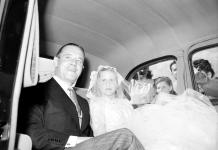
1959
If one had to assign a title to this image, “Detroit’s Confluence of the Old and New” would be as fitting as any. The city’s architectural landscape was changing after World War II, particularly as the new Civic Center buildings sprang up.
Old structures were beginning to come down, and fresh faces were replacing them. In the foreground is the spanking-new National Bank of Detroit building, which opened in September 1959. At 611 Woodward Ave., it replaced Detroit’s first skyscraper, the Hammond Building, erected in 1889 and demolished in 1956 to make way for the 14-story NBD building, now called the Qube, part of the Quicken Loans empire. Before the Qube, it was named Chase Tower and, preceding that, Bank One Center.
There are two throwbacks to the 19th century here: the Michigan Soldiers’ and Sailors’ Monument (1867) on Campus Martius, and to NBD’s immediate right, Old City Hall (1871), the latter of which would meet the wrecking ball in 1961. In its place came Kennedy Square, supplanted by the One Kennedy Square building. Pictured also are some of Detroit’s most notable skyscrapers, both then and now: the Penobscot tower (1928) behind NBD, with the Dime Building (1912, now Chrysler House) to the right rear of the Penobscot. At left rear is the Guardian Building (1929).
Across Woodward is the facade of the First National Building, NBD’s original home, built by Albert Kahn in 1922. Kahn died in 1942, but the firm bearing his name, Albert Kahn Associates, which still thrives today in the city’s New Center, designed the new NBD structure. Although some have criticized the often sterile, unornamental style of post-World War II architecture, there are some notable exceptions, and this is one. It’s a marvel of modernism, with a checkered window pattern of white marble and glass.
W. Hawkins Ferry, author of The Buildings of Detroit, also praised how thoughtfully it was situated. “The building was set back 40 feet from the street to make way for an esplanade shaded by a double row of trees. The two-story main banking room is faced by a glass wall, which is recessed behind a colonnade.”
This story is from the September 2022 issue of Hour Detroit magazine. Read more in our digital edition. Check out even more historical photos of Detroit in The Way It Was archives at HourDetroit.com.
|
|
|









